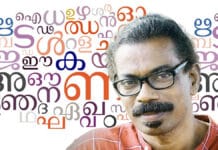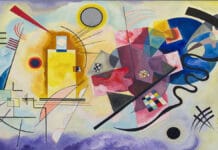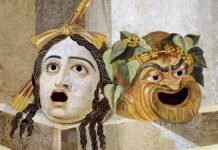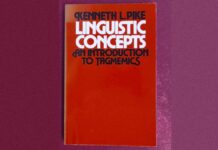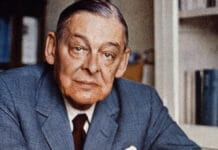Tragicomedy is a genre that blends elements of comedy and tragedy. Most often seen in dramatic literature, it can have a happy ending or a tragedy with enough comic relief to improve the mood of the entire play. The characters in tragicomedy are mostly exaggerated, and sometimes, there might be a happy ending after a series of unfortunate events. Jokes are incorporated throughout the story to lighten the tone.
The concept of tragicomedy can be traced back to ancient Greek and Roman theatre. The definition of tragicomedy was first used by the Roman playwright Plautus. He was a comic writer, and his only play with mythological implications was called Amphitryon. Generally, comic plays did not feature gods and kings, but Plautus was only accustomed to writing comedies. Therefore, in the prologue to Amphitryon, Plautus announced, via the character Mercury, that this play would inhabit a new genre form: “I will make it a mixture: let it be a tragicomedy. I don’t think it would be appropriate to make it consistently a comedy when there are kings and gods in it. What do you think? Since a slave also has a part in the play, I’ll make it a tragicomedy”.
Tragicomedy became particularly popular during the Renaissance, with playwrights like William Shakespeare and John Fletcher exploring the genre. The genre has continued to evolve, influencing modern theatre, film, and literature. Contemporary works often blend tragedy and comedy to explore complex social and psychological themes.
Characteristics
Blend of Tragic and Comic Elements
- Combines serious, sombre themes with humorous, lighthearted moments.
- Characters often find themselves in dire situations that are alleviated by comic relief or absurdity.
Complex Characters
- Characters are typically well-developed and multifaceted, exhibiting both flaws and virtues.
- Protagonists may face serious moral dilemmas or tragic circumstances but respond with humour or resilience.
Mixed Tone
- The tone shifts between serious and comic, often within the same scene or narrative arc.
- This juxtaposition creates a nuanced emotional experience for the audience.
Unpredictable Outcomes
- Unlike traditional tragedy or comedy, the outcome of a tragicomedy is not easily predictable.
- The narrative may include unexpected twists that defy conventional genre expectations.
Reflection of Real Life
- Tragicomedy mirrors the complexity of human experience, where joy and sorrow, hope and despair often intermingle.
- It emphasises the unpredictability and duality of life.
Themes and Motifs
Human Resilience
- Tragicomedies often highlight the resilience of characters who face adversity with humour and hope.
- This resilience can lead to personal growth and unexpected positive outcomes.
Irony and Absurdity
- The genre frequently employs irony and absurd situations to underscore the unpredictability of life.
- Characters may find themselves in absurd predicaments that evoke both laughter and sympathy.
Ambiguity and Duality
- Tragicomedy embraces ambiguity and the coexistence of opposites, such as joy and sorrow, hope and despair.
- This duality reflects the complexity of human emotions and experiences.
Social and Moral Critique
- Through its blend of genres, tragicomedy often provides a platform for social and moral critique.
- The juxtaposition of tragic and comic elements can highlight societal flaws and human follies.
Notable Works
The Merchant of Venice by William Shakespeare is considered one of the most famous examples of tragicomedy. Though it has a comedic structure, there are tragic characters, such as Shylock (who is a central character), and tragic events, such as Antonio’s “loss” of life (because he is not dead). Although the play ends on a happy note with the union of the lovers in the story, and Antonio is saved from a tragic incident, readers are left with a taste of Shylock’s sufferings. Hence, the feeling and mood of the play at the end are neither happy nor gloomy. Though this play has a comic structure, it also has a solid tragic story. Therefore, it can be classified as a tragicomedy.
Anton Chekhov’s play, The Cherry Orchard, turned out to be his final play, combining comedy and tragedy. It is the story of an elite family on the verge of losing its inherited estate. As this play is based on an inevitable social change which came with the dawn of the 20th century, it presents the end of an aristocratic era, blended with tragic and comic elements. The comic elements can be seen in the behaviour, humorous aspects, and lack of responsibility of the characters.
Samuel Beckett’s Waiting for Godot is also considered a great example of tragicomedy. There are many gestures, dialogues, actions, and situations that are filled with pure comedy. All types of musical devices have been used to create laughter. The overall atmosphere is that of a dark comedy. For example, Vladimir is determined not to listen to Estragon’s nightmare. However, the latter keeps pleading with him to hear. Similarly, Estragon takes off and puts on his shoes several times while Vladimir repeatedly plays with his hat. On the other hand, comedy turns into a tragedy due to the haplessness of these tramps. Vladimir and Estragon wait for somebody who does not come, which disappoints them. With time, they indulge themselves in meaningless activities.
Shakespearean tragicomedies have complex and dubious plots. One of his perfect tragicomedies is The Winter’s Tale. The first three acts are tragic and serious, while the final two are based on pastoral romance, mischief, songs, humour, and reunion. A sheep-shearing celebration with the elegant, innocent Perdita serving as a hostess, dancing and singing with shepherds, suggests rural life in England. The blend of suffering, sorrows, humour, romance, forgiveness, and reunion in the play confirms its label as a tragicomedy. There are different aspects of the tragicomedy in the play, including tragic elements, comic elements, romantic elements, and a happy ending.
The Caretaker, written by Harold Pinter, is mixed with two modes, tragedy and comedy, and is a fine modern example of tragicomedy. The comic elements come out in the monologues of Mick and Davies, and even the interactions between characters sometimes approach farce. Davies’ repetition, confusion, and deceit of the brothers make the play comedic. However, the tragic element appears in Anton’s climactic monologue regarding his shock treatments at the end of the play and in “that place,” although its ending is somewhat ambiguous.
Structure and Conventions
Plot Structure
- Tragicomedies often have a complex plot structure that includes serious and humorous episodes.
- The narrative may shift between tones, creating a dynamic and engaging story.
Characterisation
- Characters are typically complex and multifaceted, capable of eliciting empathy and amusement.
- Protagonists often face significant challenges but retain a sense of humour and humanity.
Dialogue
- The dialogue in tragicomedies is a blend of serious and humorous language.
- Wit, irony, and wordplay are typical, adding layers of meaning to the interactions between characters.
The primary purpose of tragicomedy is to describe the dual nature of reality, where both modes can coexist, perhaps simultaneously. Therefore, the interweaving of both aspects gives a comic and tragic view of life. Tragicomedy is mainly used in dramas and theatre. Since tragic plays focus exclusively on protagonists, while comic plays are devoid of focus and concern, therefore plays that fell between these two categories were developed. These types of plays present both modes of life through absurdity and seriousness.
Different cultures and eras had their approach to tragicomedy, and yet it has endured as an important genre for thousands of years. As the German writer and philosopher Gotthold Ephraim Lessing noted, “Seriousness stimulates laughter and pain-pleasure.“ Tragicomedy allows literature to explore depths and paradoxes of human experience unavailable to strict comedies and tragedies.


